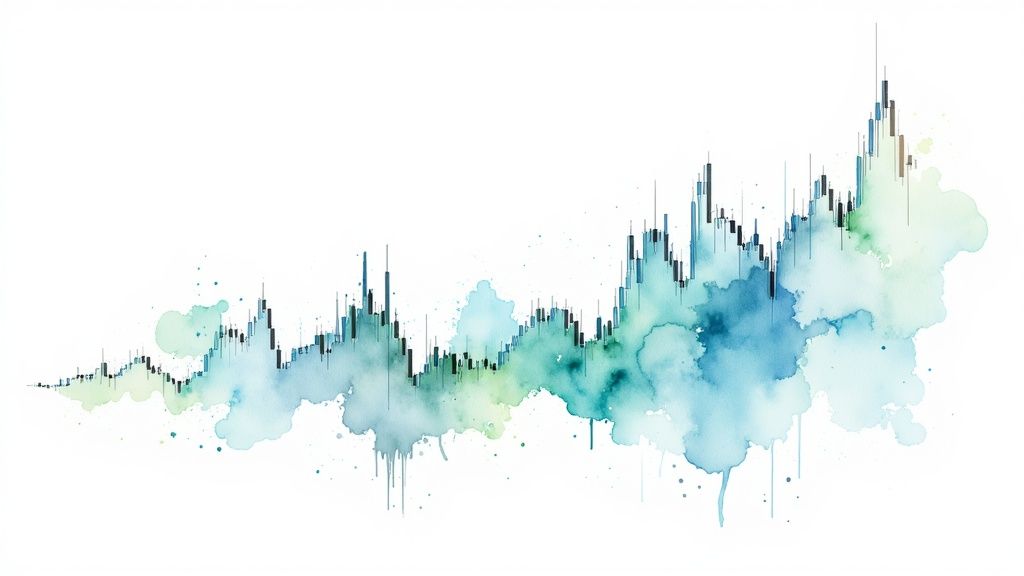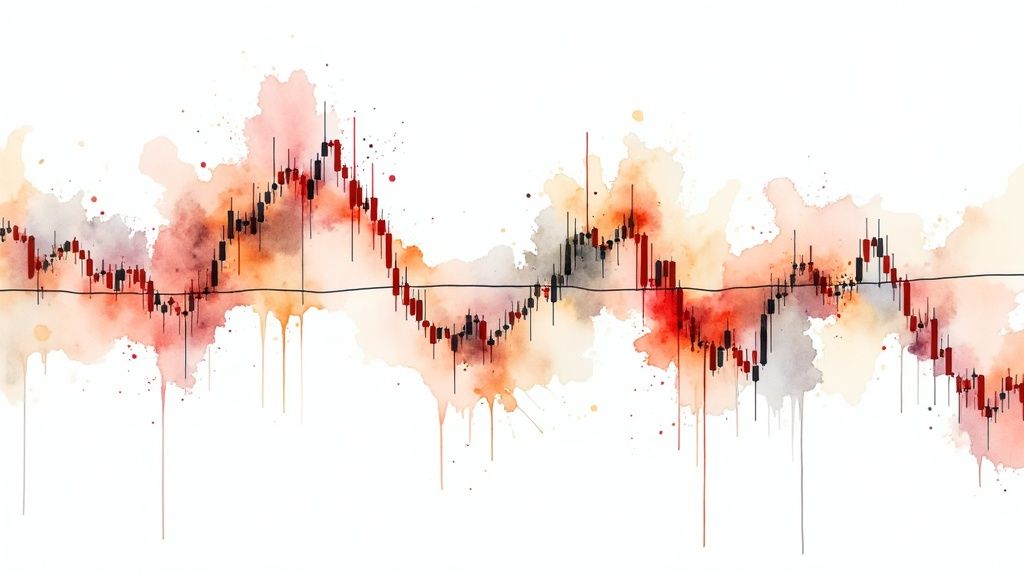




The art of technical analysis has grown considerably since Charles Dow first outlined his market theories. While his core ideas about trends and price action remain important, successful traders now combine proven principles with advanced tools to better read market behavior. This evolution demands a deeper understanding of how technical analysis works in real-world trading.
Practical application is central to modern technical analysis. Take classic chart patterns like head and shoulders or double tops - while understanding these formations is valuable, experienced traders know they rarely appear in perfect textbook form. Instead, traders focus on grasping the underlying supply and demand dynamics these patterns represent, adapting their analysis to each market's specific conditions. This flexible mindset helps identify opportunities even when patterns look messy or incomplete. Many traders also incorporate quantitative techniques, testing their strategies rigorously with historical data to refine their approach.
Technical indicators provide essential data points, but knowing what they measure is just the start. The real skill lies in applying these tools effectively. For example, when using the Relative Strength Index (RSI) to spot overbought or oversold conditions, traders often pair it with moving averages to confirm potential reversals. This multi-indicator approach creates a more complete market view. At the same time, successful traders avoid overcomplicating their analysis with too many indicators. They select a focused set of tools that align with their strategy and understand the limitations of each one.
Modern technical analysis emphasizes viewing charts within their broader context. Signals from indicators and patterns carry more weight when considered alongside market sentiment, news events, and economic factors. This is especially true in cryptocurrency markets, where headlines can spark major price moves. Understanding psychological factors like fear and greed also helps traders maintain discipline when executing their plans. For instance, a trader might spot a strong bullish signal but choose to wait for additional confirmation if overall market sentiment is heavily negative.
Modern technical analysis combines time-tested concepts with practical tools and psychological awareness. By focusing on real-world application, thoughtfully combining indicators, and considering the full market context, traders improve their ability to spot and act on profitable opportunities. This balanced, practical approach helps distinguish consistently profitable traders from those who struggle to succeed.
"Building Your Technical Indicator Arsenal" section:

The foundation of effective technical analysis lies in choosing the right mix of indicators for your trading strategy. Rather than trying to use every available tool, success comes from carefully selecting indicators that work well together and match your trading approach. Understanding both what each indicator measures and how to apply it practically in trading decisions is essential.
Using multiple complementary indicators provides deeper market insights and helps confirm trading signals. For instance, pairing the Relative Strength Index (RSI) with moving averages can offer clearer trade signals. When a bearish RSI divergence appears alongside a break below a key moving average, it presents a strong indication of a potential downtrend. However, it's critical to avoid overcomplicating analysis with too many indicators, as this can lead to confusion and indecision.
Each technical indicator comes with adjustable parameters that need to be fine-tuned based on your trading timeframe and market conditions. A 20-day moving average will respond more quickly to price movements compared to a 200-day moving average, making it more suitable for shorter-term trading. The key is matching these settings to your trading style. Beyond the mechanics, grasping the psychological aspects of indicators adds another dimension to analysis. The RSI, for example, reveals market sentiment through measuring fear and greed cycles.
Several indicator combinations have demonstrated consistent effectiveness across different markets:
Moving Averages Crossover: This method uses two moving averages of different lengths. Buy signals occur when the faster average crosses above the slower one, while sell signals appear when it crosses below. This approach helps identify trending markets.
MACD and RSI: The Moving Average Convergence Divergence (MACD) combined with RSI offers strong trend reversal signals. When both indicators show bearish divergence from price, it suggests trend weakness. Conversely, bullish divergence may indicate a potential market bottom.
Bollinger Bands and Stochastic Oscillator: This pairing excels at identifying potential breakouts and extreme market conditions. When price touches the upper Bollinger Band with the Stochastic above 80, it suggests an overbought market. The opposite setup, with price at the lower band and Stochastic below 20, points to oversold conditions.
These examples demonstrate common approaches, but finding the right combination depends on your personal trading style and chosen markets. Before committing real capital, thoroughly test any strategy using historical data to evaluate its performance. Quality data is essential for accurate backtesting and strategy refinement. By carefully selecting complementary indicators, optimizing their parameters, and understanding market psychology, you can build a robust technical analysis framework that helps you make more informed trading decisions.

Success in technical analysis requires the ability to distinguish real market trends from random price fluctuations. While proper trend identification allows traders to profit from sustained price movements, mistaking market noise for trends can result in significant losses. Understanding how to analyze trends properly builds on fundamental technical analysis concepts.
Several key tools help traders spot genuine trends. Moving averages smooth out price data to reveal underlying directional movement. For instance, when a shorter-term moving average (like 20-day) crosses above a longer-term one (like 200-day), it often signals an emerging uptrend. This works because shorter averages react more quickly to changing market sentiment. Traders also draw trendlines by connecting key price points - higher lows in uptrends or lower highs in downtrends - to visualize trend direction and strength.
Volume provides essential context for validating trend signals. Strong volume accompanying price increases suggests real buying pressure supporting an uptrend. In contrast, rising prices with declining volume may indicate a weak trend likely to reverse. Think of volume like crowd reaction - enthusiastic cheering shows conviction while scattered applause hints at uncertainty. Adding volume analysis helps filter out false signals and provides deeper insight into market dynamics.
Certain price patterns can reveal emerging trends early. A breakout above resistance with increased volume often marks the start of an uptrend. Flag and pennant patterns represent brief consolidations before trend continuation, like a spring coiling before release. However, since not every breakout leads to a sustained move, combining pattern analysis with other technical indicators and volume helps confirm likely trends. This multi-faceted approach improves the reliability of trend identification.
The mental challenges of trend trading require careful management. Price pullbacks and consolidations can shake confidence and trigger premature exits. Following a clear trading plan with defined profit targets and stop losses helps traders maintain discipline and avoid emotional decisions. Understanding how wins and losses affect trading psychology is crucial for successfully navigating trends over time. By combining technical analysis with strong psychological preparation, traders can better capitalize on trending markets.

Technical analysis requires more than just studying charts and indicators - it demands a deep understanding of market psychology and the ability to spot patterns in real-world conditions. By developing these skills, traders can move beyond rigid analysis and grasp the human behaviors that drive price movements.
While technical indicators provide valuable data points, they ultimately reflect the collective psychology of market participants. Strong emotions like fear and greed directly impact price action in predictable ways. For instance, when a breakout occurs with high volume, it often signals robust buyer conviction that can fuel further upward momentum. In contrast, declining volume during an uptrend may indicate waning interest and potential reversal as bullish sentiment shifts to caution. By understanding these psychological factors, traders can better interpret technical signals. For more insights, see: How to master cryptocurrency sentiment analysis.
While learning classic chart patterns is essential, markets rarely display perfect textbook examples. This is where refined pattern recognition skills become crucial. Experienced traders develop an instinct for spotting patterns even when they appear distorted or incomplete. The key is understanding the core supply and demand dynamics that patterns represent, rather than fixating on exact shapes.
Improving pattern recognition requires structured practice and consistency. One effective method involves regularly studying historical charts to actively identify patterns and analyze their outcomes. Additionally, maintaining a detailed trading journal to document patterns, trades, and results provides concrete feedback that accelerates learning.
Creating a profitable technical analysis trading strategy requires extensive testing and continuous refinement to ensure consistent real-world performance. Success depends on a systematic, data-driven approach that includes thorough backtesting, careful performance evaluation, and strategic optimization.
Backtesting is a critical first step where you test your trading strategies against historical market data to assess their potential effectiveness. However, running backtests without proper methodology can lead to misleading results. A common mistake is "curve-fitting" - excessively adjusting parameters until the strategy shows excellent historical performance but fails in live trading because it's too specifically tuned to past market conditions. For example, traders often fall into the trap of repeatedly tweaking indicators until they find the perfect settings for a specific historical period, only to see the strategy fail when market conditions change.
The key to effective backtesting lies in out-of-sample testing - evaluating your strategy on data not used during the optimization phase. This provides a more accurate picture of how your strategy might perform in future market conditions. A practical approach is to split your historical data into distinct periods - for instance, using the first 5 years to develop and optimize your strategy, then testing it on the subsequent 5 years of data. This method helps prevent over-optimization and provides more reliable insights into the strategy's real-world potential.
Ongoing performance monitoring forms the backbone of successful trading. By tracking essential metrics like win rate, risk-reward ratios, and maximum drawdown, you gain clear insights into your strategy's effectiveness. These metrics reveal important patterns - for instance, if you notice a high win rate but poor overall returns, this might indicate you're taking profits too quickly while letting losses grow too large. Regular analysis of these performance indicators allows you to make informed adjustments to your approach based on concrete data rather than emotion or guesswork.
Strategy refinement extends beyond simple parameter adjustments. It often requires fundamental changes to your trading logic based on observed market behavior. This might mean introducing new filters during volatile periods, adjusting position sizing based on market conditions, or combining multiple indicators to confirm trade signals. For instance, if your trend-following strategy struggles during choppy markets, you might add momentum indicators to help identify stronger trends and avoid false signals. This process of continuous adaptation helps maintain consistent profitability as markets evolve.
Managing risk effectively is essential for sustaining profits when trading with technical analysis. While finding profitable trade setups is important, the ability to handle losses properly distinguishes consistently successful traders from those who struggle. Let's examine the key risk management approaches that experienced traders use to protect their capital.
The foundation of effective risk management is determining appropriate position sizes for each trade. Rather than using a fixed percentage of capital per trade, experienced traders adjust their position sizing based on market conditions and specific setups. For instance, when a trade requires a wider stop-loss, a trader might reduce the position size to keep potential dollar losses consistent. During periods of high market volatility, traders often decrease position sizes to guard against outsized losses. This flexible approach helps maintain steady risk exposure as market conditions change.
Stop-loss orders provide critical protection by automatically closing positions when prices move against you. These predetermined exit levels prevent emotional decision-making during stressful market moves. The optimal stop-loss placement depends on factors like current volatility and your chosen technical strategy. In volatile markets, wider stops help avoid premature exits from normal price swings. During calmer periods with clear support and resistance levels, tighter stops often work better. Like trendlines that help identify potential price moves, stop-losses establish firm boundaries for potential losses.
Handling multiple open positions requires careful attention to portfolio-wide risk factors. While diversifying across different markets can reduce risk, even diversified portfolios need constant monitoring. Consider holding several technology stocks - although spread across different companies, a broad tech sector decline could impact all positions simultaneously. This highlights why understanding correlations between assets matters. Taking multiple trades based on similar technical patterns also concentrates risk exposure. By actively tracking correlations and spreading positions across truly independent markets, traders can build more resilient portfolios.
Successful traders recognize that changing market conditions require ongoing refinement of risk management approaches. When volatility increases, tightening stops and reducing position sizes helps preserve capital. In calmer periods, wider stops and larger positions may be appropriate. Just as technical indicators need periodic adjustment, risk parameters must evolve with market dynamics. This willingness to adapt allows professional traders to maintain consistency despite unpredictable market behavior.
Ready to elevate your crypto trading with powerful market intelligence and community insights? Explore Coindive today and gain the edge you need to succeed in the dynamic world of cryptocurrencies: https://coindive.app